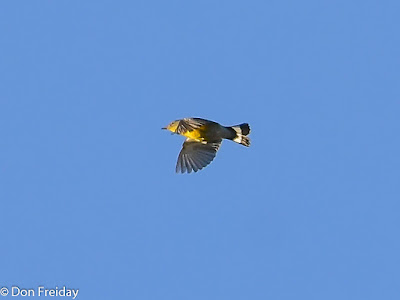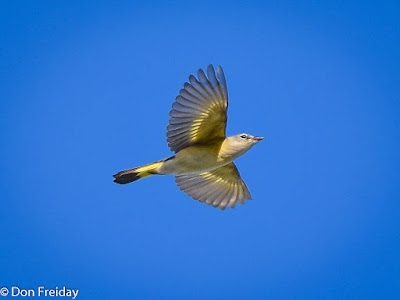[Birds in flight. It's often what you do in Cape May, NJ. All photos from today; click to enlarge.]
Your first question is, why isn't it an
American Redstart? Because, in late August and early September, if it is little and flying north (i.e. in morning flight or redirected flight), it very probably is. This morning I saw ~650 warblers in flight, and 552 were American Redstarts (I used a clicker for them). Later in fall, the question will be, why isn't it a Yellow-rumped Warbler?
The bird above, frozen with wings open by the camera, is a gimme, or should be. A thing about trying to i.d. warblers in flight is that you must know the bird cold when it is perched - so do you know the redstart's tail pattern, it's exact wing pattern, its face, and its range of variability? Other than that, if it is a slim, long-tailed warbler with a dark-tipped tail that is kind of spoon shaped and it jinks around a lot in flight and often chases other birds, and says tsweet a lot, it's a redstart.
[
This is one that could stump you even if seen well and perched.]
When watching a good morning flight in early fall, one thing I try to do is find warblers flying by that are not redstarts. Shorter tails, less jinking in flight, different flight call (a lazy zeep on the one above), different color pattern . . . e.g., the bird above, which front to back below is yellow, white, black. Fall female
Magnolia Warbler, a tricky one with no streaks below at all.
Above, tiny little thing with a tiny bill, yellow on the chest, obvious wing bars, blue and green above, says
tsiw. . .
Northern Parula.
Last one. Once I was working with a new morning flight counter with Richard Crossley, and at one point Richard burst out exasperated, "They're all bloody yellow!" What he meant was, in the low angle sun of morning flight, anything can look yellow. However, this one looked most yellow on the face and throat, had something going on with the face pattern (in the split-second look of a warbler in flight, "something going on" is sometimes all you can do), seemed streaked, and had obvious wing bars. Female
Blackburnian Warbler.
Today's was a great flight, spiced with orioles and lots of Red-breasted Nuthatches. Keep the binoculars and reflexes sharp - we're currently waiting to see what tropical storm Hermine brings us, and then the next cold front.






















